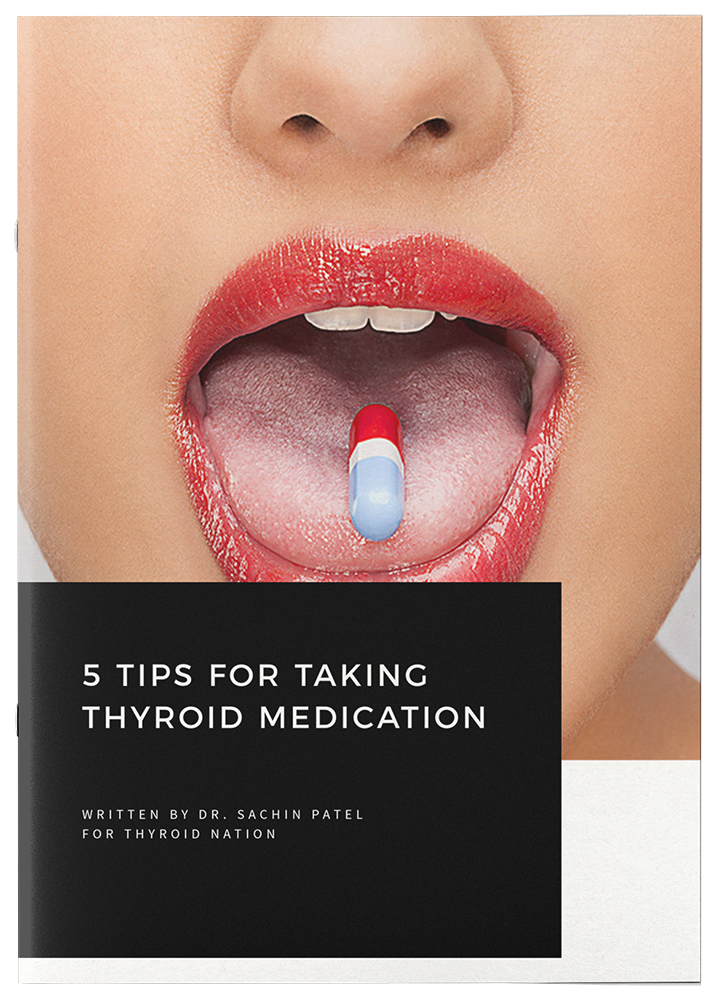
Dr. Bryan P. Walsh, Precision Nutrition
Thyroid Nation
Dr. Walsh discusses 8 thyroid issues:
Imagine seven people all lined up next to each other. Each one of the reports that they have the exact same symptoms: fatigue, difficulty losing weight, constipation, the “blues”, cold hands and feet, and feeling puffy all the time.
These are all classic symptoms of hypothyroidism, or a low functioning thyroid gland, but what I’m about to show you is that each of these seven people can have a different defect in thyroid physiology.
Worse yet, there is a strong likelihood that none of them will be diagnosed correctly.
The thyroid: Your fat-burning gland
The thyroid gland is the main metabolism gland in your body. As said previously, if your thyroid is not working correctly, you will have a difficult time losing weight. However, the thyroid does so much more than that.
- Every cell in the body has receptors for thyroid hormone
- Low thyroid hormone leads to elevated cholesterol, triglycerides and gall stones
- There’s a higher chance of mental retardation in children whose mothers had low thyroid function during pregnancy
- Low thyroid hormone leads to poor digestive function, including low digestive enzymes and constipation
- There are intimate connections between the thyroid and other hormones
- For example, thyroid hormone makes progesterone receptors more sensitive, meaning a woman with hormonal symptoms every month, may actually have a thyroid issue driving it
- Low thyroid hormone can impact neurotransmitters
- For example, low thyroid hormone can cause low dopamine levels, leading to loss of motivation and will-power
In the end, as you can see, the thyroid is an important gland. It is also a very sensitive gland. The thyroid gland is negatively impacted by a number of external chemical influences such as chlorine, fluoride, some heavy metals, and other synthetic chemicals. This is one of the explanations why there are so many thyroid issues today.
But here is the reality. There are millions of people with thyroid issues that do not know it because of flaws in understanding of basic thyroid physiology and in the way the thyroid is tested today.
Symptoms
Symptoms of low thyroid hormones are vast. This indicates just how far-reaching the effects of thyroid hormone are.
Some low thyroid symptoms include:
- fatigue
- weakness
- weight gain
- difficulty losing weight
- coarse, dry hair,
- dry skin
- hair loss
- cold intolerance (you can’t tolerate cold temperatures like those around you)
- muscle cramps and frequent muscle aches
- constipation
- depression
- irritability
- memory loss
- abnormal menstrual cycles
- decreased libido.
If you have several (or all of these symptoms), you should probably get some physiological testing done.
Problems with testing
Before you get tested, understand there are three major problems with laboratory testing.
- Broad reference ranges – Ranges are created using people who go to the doctor, not healthy ones. Therefore the reference ranges are far too broad to catch minor fluctuations in thyroid physiology.
- Non-standardized reference range – Not only is the reference range too broad, but it varies from lab to lab, and state to state. Therefore you can have a thyroid issue in one state, but not another. That’s not healthy.
- Insurance company influence – Doctors only run tests that are considered “medically necessary” by insurance companies. Therefore, doctors won’t often run a good thyroid panel because most insurance companies won’t pay for them.
Fortunately, testing for thyroid issues is available for some people in select areas. More on that in a bit.
Thyroid physiology
Here’s a promise. If you understand this section, you will have a better working knowledge of thyroid physiology than most doctors.
Thyroid physiology is more complicated than this, but here is a basic working foundation of it that works very well in identifying the majority of thyroid issues.
There is a section in your brain called the hypothalamus that releases thyrotropin releasing hormone (TRH). It tells the pituitary gland to produce thyroid-stimulating hormones (TSH), which then tells the thyroid how much hormone to produce.
The thyroid gland itself puts out a number of thyroid hormones, most of it being thyroxine, otherwise known as T4. Over ninety percent of thyroid hormone produced by the thyroid gland is T4, which is considered to be a prohormone because it has minimal metabolic effects on the body. Triiodothyronine (T3) is the active thyroid hormone, but only seven percent is produced by the thyroid gland. The rest has to be converted from T4.
The majority of thyroid hormones produced by the thyroid are bound to a protein (thyroid-binding globulin) to transport them around the rest of the body. At some point in their travels, T4 is converted to T3 in many tissues of the body, primarily the kidney and liver, and free T3 then gets into the cells to exert its metabolic effect.
It should also be noted that twenty percent of thyroid hormone, T3 sulfate and T3 acetic acid, must be converted to active T3 by gut bacteria.
What can go wrong
Getting back to the line of seven people, all experiencing the exact same symptoms, here is how they can all have thyroid issues, but have a defect in a different area of thyroid physiology and therefore all requiring different treatment.
Defect #1 – Pituitary
If the pituitary is not functioning correctly, it cannot produce adequate amounts of TSH to stimulate their thyroid. This is most often due to suppression of the pituitary by cortisol.
Defect #2 – Thyroid
This defect is medically referred to as primary hypothyroidism, which is the one dysfunction doctors actually look for. However, the reference range for TSH is so wide, many people with this defect will be missed. Also, many people with this defect have an autoimmune thyroid condition (see Bonus Defect below).
Defect #3 – Thyroid binding globulin (TBG)
If there is too much thyroid-binding globulin, thyroid hormone would be bound and unable to get into the cell. Thyroid function may be perfect, but if it’s all bound, it can’t get into the cells. This is most commonly caused by elevated estrogen in both men and women.
Defect #4 – Thyroid binding globulin (TBG)
If there is not enough thyroid-binding globulin, there can be too much free thyroid hormone available for cells. While this doesn’t sound like a problem, elevated free thyroid hormone shuts down receptor sites and can, therefore, cause hypothyroid symptoms, despite high free thyroid hormone levels. The most common cause of this is elevated testosterone in both men and women.
Defect #5 – Conversion
If inactive T4 cannot be converted to T3, there will not be enough active thyroid hormone for cells. This can be due to a number of issues including certain mineral deficiencies (i.e. selenium), elevated cortisol or excessive oxidative stress.
Defect #6 – Dysbiosis
It is difficult to know the degree that dysbiosis can cause thyroid physiology issues. Because twenty percent of thyroid hormone is converted to active T3, if there is significant gut issues, or lack of healthy gut bacteria, there may be low thyroid symptoms.
Defect #7 – Thyroid Receptor
If thyroid hormone cannot get into the cell there will be low thyroid symptoms despite thyroid hormone levels in the body. Receptor site defects can be caused by elevations in cortisol, homocysteine or vitamin A deficiency.
Bonus defect – Autoimmune thyroid
In industrialized countries, the vast majority of primary hypothyroidism issues (Defect #2) are due to an autoimmune condition called Hashimoto’s syndrome. If this is the case, it is no longer a thyroid issue, but rather an immune system issue and must be managed as such.
Seven different people. Seven different issues. All resulting in the exact same symptoms. And most of the issues probably missed in the conventional medical system.
What to do
To be honest, I’d love to tell you what to do for each of these. I really would. But it is not as easy as that. Without proper testing and a complete assessment, it’s hard to pin down the one or two things you’ll need to do to resolve a thyroid issue.
However, when traveling down the road to being healthy, you must start with the first few steps. Here they are:
- Take a good look at the hypothyroid symptoms listed earlier in the article. If you have many of those symptoms, you may want to look deeper into your own physiology with testing.
- Next, get a good blood work thyroid panel done. A good panel includes TSH, total T4, free T4, total T3, free T3, T3 uptake and thyroid antibodies (TPO and anti-thyroglobulin).
- Get it interpreted by someone who uses a functional/optimal reference range and actually understands thyroid physiology.
In the end, the thyroid is a very different gland when it comes to health, as well as our ability to lose weight. When functioning well, you’re laughing. However, when your thyroid system isn’t functioning well, there are a lot of links in the chain that need to be examined.
Eat, move, and live… better.
Yep, we know…the health and fitness world can sometimes be a confusing place. But it doesn’t have to be.
Let us help you make sense of it all with this free special report.
In it you’ll learn the best eating, exercise, and lifestyle strategies – unique and personal – for you.
**This article originally featured at PrecisionNutrition.com**
About the Author
 Dr. Bryan Walsh is a Naturopathic Physician helping to manage a variety of conditions, but specializes in autoimmune thyroid conditions as well as weight loss for active men and women who are not losing weight using good diet and exercise programs. He has created a multi-media product called Fat Is Not Your Fault offering a manual, assessment form, audio interpretation guide and over 10 hours of video covering the many different reasons people aren’t losing weight.
Dr. Bryan Walsh is a Naturopathic Physician helping to manage a variety of conditions, but specializes in autoimmune thyroid conditions as well as weight loss for active men and women who are not losing weight using good diet and exercise programs. He has created a multi-media product called Fat Is Not Your Fault offering a manual, assessment form, audio interpretation guide and over 10 hours of video covering the many different reasons people aren’t losing weight.
Questions or anything to ask Dr. Walsh about thyroid issues? We want your thoughts in the comments section–Please!



